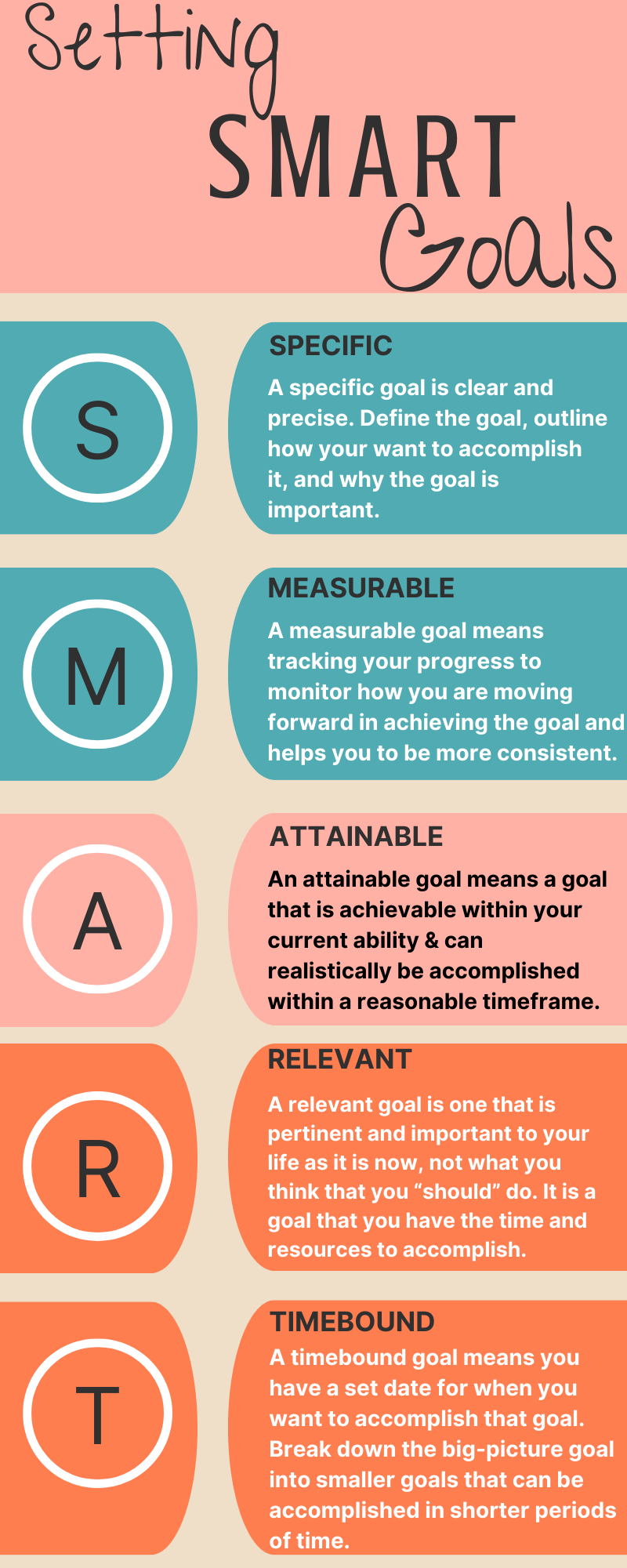Setting SMART Fitness Goals [Infographic]
Are you setting resolutions for the new year? Too often, we name aspirational resolutions without having a clear plan to achieve them. This year, try using the SMART goal setting framework to help you create specific, measurable, attainable, relevant, and timebound goals.
SMART Goal Setting
S: SPECIFIC
A specific goal is clear and precise. It’s important to define the goal, break down how you want to accomplish it, outline smaller achievable goals to help you accomplish the big-picture goal, and state why the goal matters and is important to you.
Example:
Clear, defined goal: Increase my daily step count to 10,000 steps per day in the next 6 months.
Set Achievable Smaller Goals: Wake up an hour earlier and go for a morning walk for 20 minutes three times a week. Once you’ve achieved that, work up to walking each morning five times a week, then 7 times a week.
Why: To improve my overall fitness and strength.
M: MEASURABLE
A measurable goal means tracking your progress to monitor how you are moving forward in achieving your goal. This helps you see clear progress and motivates you to stay consistent.
Example:
Measurable: Use an apple watch, Fitbit, or pedometer to count your steps on each of your walks and your daily movement.
A: ATTAINABLE
An attainable goal means a goal that is achievable within your current ability and can realistically be accomplished within a reasonable timeframe. Avoid setting extreme goals that are nearly impossible to accomplish in a certain timeframe such as trying to run a marathon with just one month of training. Assess your current ability and plan out your workouts so that you can gradually prepare your body for the goal you wish to accomplish.
Example:
Attainable: If you haven’t been active for quite some time, evaluate your current cardiovascular capacity and start small with short 10-minute walks each morning. As you build up stamina, expand your walking time to 20 minutes. A twenty-minute daily walk accounts for about 2,400 average steps. Maintain that schedule and then start building in a 40-minute walk, or three 20-minute walks each day to start increasing your steps.
R: RELEVANT
A relevant goal is one that is pertinent and important to your life as it is now, not what you think you “should” do. It is a goal that you have the time and resources to accomplish. If you are currently in an extremely busy work month, give yourself some grace and move the start of your fitness goal to February or March. It’s okay not to start your goal in January if it doesn’t work for your schedule.
Example:
Relevant: Assess whether this current season is the best time to start your walking goal. Do you have a particularly busy January with work or kid’s schedules? Just because it’s January doesn’t mean you have to start your walking resolution this month. Will you have more time and resources in February to begin your walking and steps goal? Start then, building up the number of steps and time walking gradually.
T: TIMEBOUND
A timebound goal means you have a set date from when you want to accomplish that goal. Break down the big-picture goal into smaller goals that can be accomplished in shorter periods of time. Give yourself a reasonable amount of time to achieve your goal and celebrate when you reach smaller goals on the way to the big-picture goal.
Example:
Timebound: Your big picture timebound goal is to walk 10,000 steps a day by July 2024 and maintain that through the end of the year. Your short-term timebound goal could then be to start with walking 2,500 steps or 20 minutes every day for the first month. In the second month, increase your walking time to 40 minutes a day, or 5,000 steps for the next month. Each month, you add more steps and more time walking to increase to your 10,000 steps a day goal, building stamina, cardiovascular capacity, and strength progressively.
5 SMART Fitness Goal Ideas
Increase your daily step count to 10,000 steps per day. Daily walking increases your cardiovascular fitness, strengthens your bones, and boosts muscle power and endurance.
Implement twice-weekly strength training sessions. Strength-training improves your strength and flexibility and decreases your risk of injury and falls. Try working with a trainer first to learn how to use the weight machines and build a progressive program suited to your current abilities.
Train for a marathon in Summer 2024. Outline a progressive running schedule over the next 4-6 months to gradually increase your cardiovascular capacity, endurance, stamina, and running ability.
Focus on building your core strength by joining a Pilates class or working with a Pilates instructor. Pilates increases your flexibility, improves muscle strength and tone particularly in the abdominals, low back, hips, and buttocks, ensures balanced muscular strength on both sides of your body, and enhances muscular control of your back and limbs.
Try plyometric training, or jump training, to build explosive power, strength, and speed. Plyometric training trains you to rapidly decelerate the body and reaccelerate in the opposite direction.
As you look forward to 2024 and dream up your resolutions for this coming year, remember to set SMART goals to achieve the changes you want in the new year!
